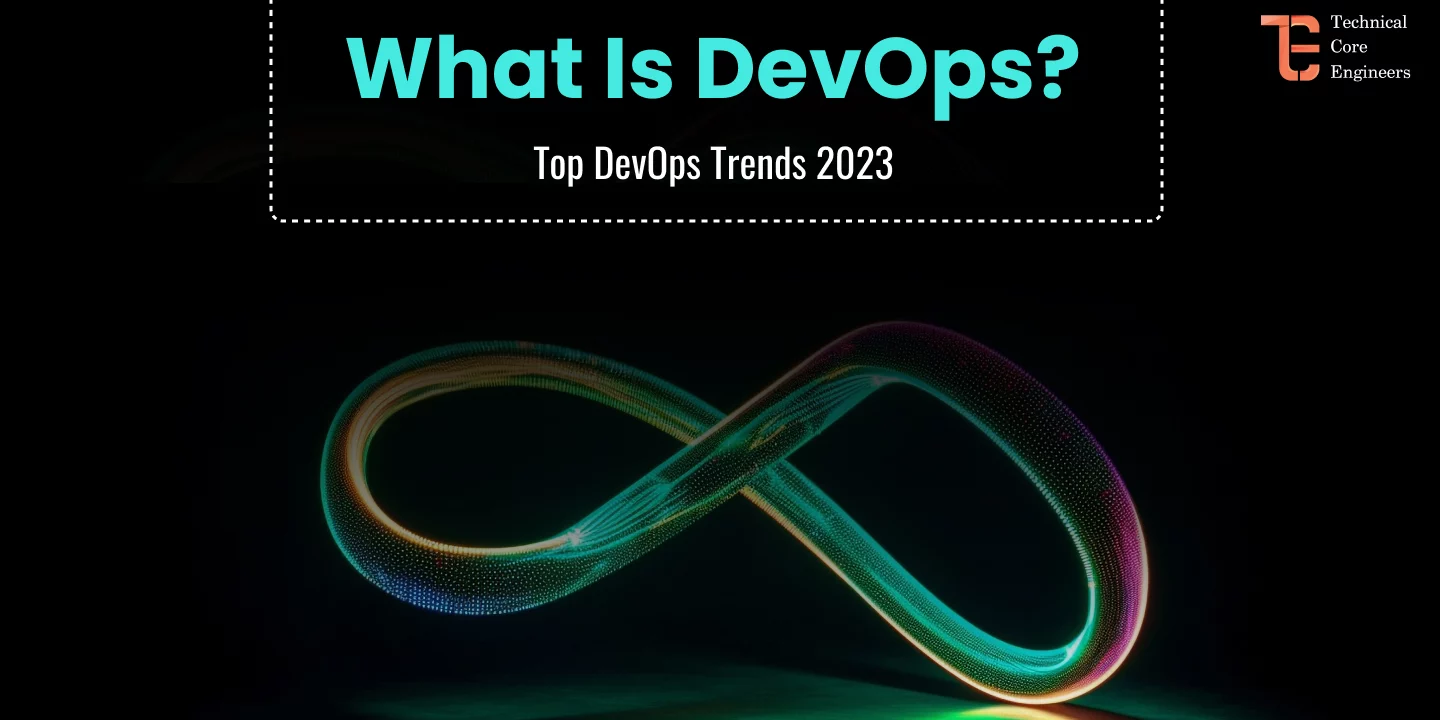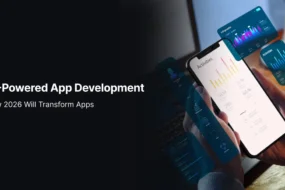- Home
- Web Development
- What Is DevOps? Top DevOps Tre ...

Within the context of contemporary software development and IT operations, DevOps is a critical and revolutionary methodology. The very phrase “DevOps” is a combination of the words “development” and “operations,” signifying the fundamental idea of merging these two historically distinct fields.
DevOps is a cultural movement that strives to promote cooperation, communication, and automation between development and operations teams rather than just a collection of tools or procedures.
What Is DevOps?
This collaborative mentality stems from the desire to produce software in a more reliable, efficient, and fast manner. We will examine the fundamental ideas, advantages, and procedures that characterize DevOps in this overview of the technique.
Knowing DevOps will help you comprehend how this technology has transformed software development and why it is still a major player in the IT sector.
Read More: Top 10 Best DevOps Tools Which You Should Know
The future of DevOps is bright and promising. DevOps’s real-world applications are expanding every day. You may improve the effectiveness and caliber of your mobile app development by being aware of what the future holds for DevOps developers.
In the next years, there should be some significant adjustments. Thus, maintain a competitive edge to improve internal operations efficiency.
Top DevOps Trends

Microservices
Today, microservice-based designs are widely use in the IT sector. Microservices, which were create to meet the latest DevOps trends, have been effective in streamlining operations, deployment, testing, and development by dividing large, cumbersome monolithic systems into smaller, more manageable components.
It has also simplified the continuous and regular supply of software and apps. Development teams may now easily and more easily facilitate DevOps practices and concepts to improve software quality.
More manageability and agility are attaine throughout the software development life cycle by using microservice architectures.
In the future, microservices will become a major player. Because smaller software components may be built by different teams, they will increase organizational competitiveness by accelerating the software development life cycle and enabling organizations to provide updates and apps faster.
Serverless
Serverless has been a buzzword in the DevOps space for some time and is bound to pick up more interest in 2023 and beyond. Many firms have been able to alter their operations by outsourcing infrastructure handling chores to outside expertise thanks to serverless computing.
This reduces the possibility of pipeline management issues by giving developers more time to concentrate on creating customer-centric apps rather than managing and maintaining servers.
Many organizations have already used a serverless strategy after realizing the benefits that it offers. With additional benefits like little to no server administration, cost savings (because customers only pay for what they use), high scalability, speedy deployment, more time to focus on UX, reduced latency, and high efficiency, the enhanced operability helps close the gap between Dev and Ops. In 2023, the serverless market is project to expand as more businesses adopt it.
Infrastructure as Code
Infrastructure as Code, or IaC, is a DevOps idea that will be very popular in 2023. It leverages automation and coding to make infrastructure provisioning and maintenance easier.
Version control, virtualization testing, and continuous monitoring of the application code are all required by DevOps best practices.
IaC is an effective method since it reduces the amount of physical labor required for these tasks. Software development and infrastructure teams may work together more effectively and closely thanks to infrastructure as code.
IaC will undoubtedly gain speed in 2023 due to the growing need for infrastructure as well as the requirement to be quick and flexible.
Multi-Cloud Environments
DevOps and the cloud go hand in hand. Because the combination gives the product pipeline more features and value, it is quite helpful for increasing efficiency.
Using a multi-cloud system strategy is becoming increasingly important, particularly for businesses looking for the finest available services from all providers.
Organizations utilize the multi-cloud strategy to support the availability of data, apps, and services.
More and more businesses are requesting a variety of services from different suppliers. It is frequently advantageous to have a multi-cloud setup to provide high availability.
Moreover, multi-cloud architectures enable the selection of cloud services with the best price or performance for particular use cases. The goals of DevOps are speed and efficiency, and using a multi-cloud strategy is one tactic that has demonstrated results in increasing both.
In 2023, a spike in the use of multi-cloud computing won’t be shocking.
Low-Code Applications
The goal of DevOps is to reduce the duration of the application development lifecycle, and low-code platforms are great resources for cutting complexity and saving time.
Quick application development and deployment have become possible for “citizen developers,” or non-technical professionals, thanks to the availability of drag-and-drop pieces that eliminate the need for complicated code writing.
When there are short delivery dates, professional developers also have a tendency toward low-code apps to a certain extent.
Reusable, tested components combined with low code can help applications become less buggy, giving businesses an advantage in a highly competitive and rapidly evolving industry.
In 2023, expect to see a greater number of vendors offering low- to no-code apps and ready-made solutions for commonly used functionality.
GitOps
One of the most revolutionary DevOps innovations and best practices to be integrated into a DevOps workflow is GitOps, which can be thought of as an extension of infrastructure-as-code.
Adopting GitOps can help organizations that want to automate application development, enhance monitoring, and better govern infrastructure.
GitOps is increasingly being used since it improves CI/CD tools, version control, communication, etc. in an efficient manner. Git is currently used by IT and development teams to efficiently manage infrastructure and roll out apps once they realize its advantages.
It will be widely utilize since it has a lot of potential to shorten the period between releases, guarantee continuous delivery, and increase the development process’ overall effectiveness.
Machine Learning
Up until recently, machine learning was thought to be the same as replicating human talents. In recent times, nevertheless, it has developed into something more.
A specific subset of DevOps called MLOps aims to use machine learning to enhance operations. MLOps and AIOps are essential to the improvement of DevOps operations in order to achieve high-quality and fast delivery.
In order to identify gaps in development, operational, and test tools, handle warnings effectively, prevent manual provisioning, and integrate workflows efficiently, machine learning techniques are essential.
Product development pipelines become more synchronized and faster as a result of all of these. It makes sense that ML technologies are becoming more and more integrated into DevOps pipelines, a trend that will continue in the upcoming year.
Artificial Intelligence
Until recently, there has been limit acceptance of artificial intelligence and exploration of its full potential. This is due to advancements in LLM (Chat-GPT) and picture production (Mid-Journey and Stable Diffusion).
But AI is starting to rule the future, and DevOps is no different. The application of AI in DevOps is developing and has significantly increased its capabilities. Artificial intelligence is already taking the place of some human elements in the development, deployment, management, and delivery of applications inside businesses.
This is especially true in situations where large volumes of data processing and ingestion are required. AI is being used more and more by organizations for the majority of standard Software Development Life Cycle (SDLC) tasks, such as testing, coding, releasing, and monitoring applications.
These adoptions are yielding benefits such as increased security, enhanced system monitoring, workflow optimization, high data accessibility, and agile implementation. Due to these advantages, more businesses are utilizing AI to increase efficiency, enhance automation, resolve problems more quickly, foster greater teamwork, and obtain a general competitive edge in the marketplace.
The sophisticated features of today’s AI-powered DevOps solutions are essential for automatically rightsizing workload setups. Their cutting-edge security and risk-detection skills are being incorporated into DevSecOps, and in 2023 they will be a major factor in determining how AI is adopted in DevOps.
Chaos Engineering
During the testing process, chaos engineering adds failure or chaos to see what kinds of problems applications can tolerate.
The intention is to force software to malfunction or malfunction under predetermined conditions.
This method provides engineers with a way to identify and address usability issues as well as other difficulties prior to application deployment, even though it could seem to cause more problems than it fixes.
Since chaos engineering supports some of the most important aspects of DevOps, such as designing more dependable apps and promoting continuous improvement through testing, it is inevitable that this method will be widely applied in the DevOps process.
The primary benefit of this technique is preventing failures that might cause delays, expense money, and effort, and disturb the development process. Chaos engineering helps companies to release better apps that users can enjoy within a broad tolerance limit, increasing customer loyalty and income. This is because the final aim is always the customer experience.
Observability
Observability refers to the ability to log, gather, and examine data pertaining to system performance. Deep system insights are provided through observability to IT teams, DevOps engineers, and stakeholders.
They can identify weak places, common failure sites, and parts of the system and effectively address these problems thanks to it. Additionally, it allows organizations to get important insights into the state of their systems so they may take proactive changes ahead of time.
Observability keeps the system dependable and efficient, which pleases the consumers. In 2023, one of the main areas of concentration will be observability due to the requirement for always-up and dependable systems.
Conclusion
One of the most important years for DevOps will be 2023. To strengthen their position in the DevOps space, all of the major software companies are expanding their product portfolios.
Furthermore, newcomer IT firms offering innovative products and services are adding to the already congested industry. The subsequent wave of the DevOps adoption revolution will be fueled by this.
Nevertheless, this might also imply a somewhat greater quantity of unsuccessful implementations because of obstacles such as inadequate labor expertise, antiquated infrastructure, and challenges in modifying organizational culture. The market for DevOps services will save the day in this situation. They may use the different product and service lineups to their advantage by utilizing the Dev and Ops





